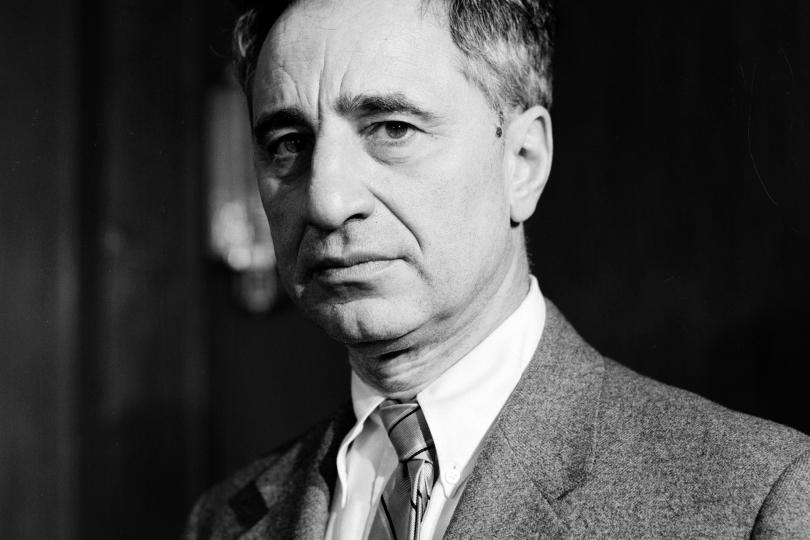Elia Kazan

Some lasting images stay with us long after the credits have flickered into the past. For example: a young soldier helps Blanche DuBois onto that famous streetcar named Desire; after learning the truth on the waterfront, Terry Malloy, seated in the back seat of a car, declares that he “coulda been a contender;” Ella Garth’s body is interred into her family plot, the only part of her land not flooded by the Tennessee Valley Authority. These impressions are from the world of Elia Kazan (1909-2003), one of the greatest directors and 20th century theater icons! It’s exciting to explore this world.
Born in Istanbul, Kazan attended the Yale School of Drama, and became a mercurial member of the Group Theater. This agitprop theater of the 1930s would later morph into the Actor’s Studio established by Kazan, Lee Strasberg, Cheryl Crawford and Robert Lewis; their chief playwright was Clifford Odets. Many members of the Group Theater would go on to join the American Communist Party and, eventually, be blacklisted.
Theatrical Career
Kazan’s career began by appearing in such productions as Men in White, Waiting for Lefty and Paradise Lost. He moved to Broadway and directing when he staged the original production of Thornton Wilder’s The Skin of Our Teeth starring Fredric March, Florence Eldridge, Tallulah Bankhead and Montgomery Clift. He guided Mary Martin to success in the Kurt Weill-Ogden Nash musical, One Touch of Venus, and directed two production of Harriet, a play about Harriet Beecher Stowe, the author of Uncle Tom’s Cabin. Truckline Café may have been a failure but it established a lifelong friendship with Marlon Brando.
Broadway and Lincoln Center
Kazan’s major successes included Arthur Miller’s All My Sons and Death of a Salesman; Tennessee Williams’ A Streetcar Named Desire, Camino Real, Cat on a Hot Tin Roof and Sweet Bird of Youth; Robert Anderson’s Tea and Sympathy and William Inge’s The Dark at the Top of the Stairs. When the Actors Studio chose to show their work, he directed Jane Fonda in a revival of Eugene O’Neill’s Strange Interlude, while Paul Newman and Joanne Woodward starred in Baby Want a Kiss.
In the early 1960s, an area of slums near Columbus Circle (59th and Broadway) were replaced by a new arts center; before demolition, Robert Wise filmed West Side Story here. In its place, arose Lincoln Center for the Performing Arts. Surrounding its Revson Fountain, to the south is the New York State Theater, renamed the David H. Koch Theater, which has housed the City Ballet and City Opera Companies; to the west is the Metropolitan Opera (sharing space with American Ballet Theater) and to the north is Philharmonic Hall, first renamed for Avery Fisher and now called David Geffen Hall. It shares space with the smaller Alice Tully Hall.
Tucked in the northwest corner are the New York Public Library for the Performing Arts and the Vivian Beaumont Theater. The basement of the Beaumont has the Mitzi E. Newhouse Theater. (This building combines the only Broadway and Off-Broadway theaters together in one complex). Ford-ham University and Julliard are nearby.
The original plan was to create a repertory company that would pair original works with new interpretations of classics. Arthur Miller’s After the Fall was its premiere production. Kazan directed Jason Robards and Barbara Loden (Kazan’s second wife) in an account of Miller’s relationship with -- and a eulogy for -- Marilyn Monroe. It shared the stage with Eugene O’Neill’s Marco Millions, also staged by Kazan, and Georg Buchner’s Danton’s Death.
As managed by Strasberg, Herbert Blau, Alfred Whitehead and others, artistic differences and infighting would ultimately end the organization, but not before Kazan added Miller’s Incident at Vichy, Moliere’s Tartuffe and a renowned production of Three Sisters starring Kim Stanley, Geraldine Page and Sandy Dennis, (available on YouTube) to the repertoire. Later, Joseph Papp ran the Beaumont, which has become a legitimate Broadway theater. (James Lapine’s musical Flying Over Sunset is its next tenant).
Hollywood Career
Due to his astounding theater record, Kazan was called to the West Coast. A Tree Grows in Brooklyn (1945) is based on Betty Smith’s Depression-era novel about a poor family told from the young daughter’s point of view. The cast features Dorothy McGuire, Joan Blondell, Peggy Ann Garner and Oscar winner James Dunn. It’s a lovely movie that’s dissimilar to most of Kazan’s other films. While poverty and alcoholism are frequent themes, this is a heartwarming family story.
Gentleman’s Agreement (1947) won the Oscar for Best Picture. It’s a compelling examination of anti-Semitism. Adapted from Laura Z. Hobson’s novel by Moss Hart and Kazan, Gregory Peck plays Phil Green, a reporter who poses as a Jew to write an expose. While his work is well-received, the experience has a devastating effect on his family, most especially, his relationship with his son. Ann Revere, Oscar winner Celeste Holm, Dean Stockwell, Dorothy McGuire, John Garfield and June Havoc appear in this surprisingly contemporary film which should be seen or seen again, especially in today’s conflicted society.
Then Kazan brought Williams’ A Streetcar Named Desire (1951) to the screen with much of the Broadway cast. Vivien Leigh, who’d played Blanche in London, was an exception. This remains the definitive interpretation of the play, winning Oscars for Leigh, Karl Malden and Kim Hunter. Written for the screen by Budd Schulberg and politically charged, On the Waterfront (1954) is about union corruption on Manhattan’s harbor. This earned Marlon Brando and Eva Marie Saint Academy Awards for their performances.
The rich technicolor Kazan used for John Steinbeck’s East of Eden (1955), make it an outstanding cinematic experience. James Dean, Raymond Massey, Julie Harris, Burl Ives, Richard Davalos and a very young Lois Smith appeared in this film. Jo Van Fleet earned an Oscar and this is the only film released five months before Dean’s untimely death. It remains one of the finest adaptations of Steinbeck ever done.
Based on a short Tennessee Williams play, Baby Doll (1956) was controversial when it was released, but today is surprisingly tame. In a small southern town, two rival cotton gin companies cause contention between the owners, played by Karl Malden and Eli Wallach (his first film). When arson destroys Wallach’s business, he seeks revenge by trying to seduce Malden’s virginal child bride, (the Baby Doll of the title). Due to its sexual overtones this film was condemned by the Legion of Decency, but the acting is outstanding. Along with Malden and Wallach, supporting players Mildred Dunnock, Lee Remick and Rip Torn deliver skilled performances. The standout, however, is Carroll Baker playing a vibrant teenager forced to sleep in a crib where she sucks her thumb, yet rages as she betrays her husband.
Andy Griffith gives his all-time best performance as a vagrant who becomes a nationwide celebrity aided by an eager executive played by Patricia Neal in A Face in the Crowd (1957).
The crises of teenage angst is the theme for Splendor in the Grass (1961). Set in the 1920s, this heartbreaking film, (based on a short play by William Inge), features Natalie Wood, Warren Beatty, Sandy Dennis, Audrey Christie and Pat Hingle. Along with Rebel Without a Cause it remains a classic among films of this nature.
Wild River (1960) features Montgomery Clift, Lee Remick and Jo Van Fleet and tells the personal story of a family uprooted by the actions of the Tennessee Valley Authority and its displacement of farmers from the land they worked for over a century. The politics within the story gives audiences the opportunity to debate the issues the film represents.
Adapted from his novels, America, America (1963) and The Arrangement (1969) focus on Kazan’s roots. The former is the story of his family’s immigration to America, and Kazan claimed it was the favorite of all his works.
The Arrangement and F. Scott Fitzgerald
When I was in high school, an actress from my hometown, Dianne Hull, in The Arrangement. While this caused a local sensation, Douglas, Deborah Kerr and Faye Dunaway were the three leads. Many of Hull’s scenes wound up on the cutting room floor. The film is an unwatchable box office failure.
Following the success of The Great Gatsby (1974) starring Mia Farrow and Robert Redford, Hollywood presumed that audiences wanted more Fitzgerald, so, in 1976, Kazan was hired to direct Harold Pinter’s screenplay for The Last Tycoon. Unfinished at the time of his death, this is a difficult novel to read. At the time Fitzgerald was suffering from alcoholism, guilt over institutionalizing his wife, (Zelda) and having an affair with writer Sheilah Graham. Clearly, he sweated every word of this book, an homage to MGM wunderkind, Irving Thalberg.
You’d think that with Robert de Niro, Robert Mitchum, Jeanne Moreau, Jack Nicholson and Ray Milland, this would be a superlative film, and, were it sharper, it could have been. However, a lot of hype was placed on Kazan’s “discovery,” Ingrid Boulting, a model who contributed little to the proceedings. Kazan’s last feature film, The Last Tycoon was a failure.
During his career, Eliza Kazan was awarded two Oscars, three Tony Awards and four Golden Globes. However, in 1999, he was booed by the audience after receiving an honorary Oscar, a long-past controversy returned to haunt him.
Blacklisting
Because of their membership (however brief) in the Communist Party, members of the Group Theater faced the House Un-American Activities Committee in the early 1950s. Kazan had been a member for 18 months in the early 1930s. Called to testify, he named names, destroying the careers of actors Morris Carnovsky and Art Smith and that of his friend, Clifford Odets. Arthur Miller would never speak to him again, and that honorary Oscar would haunt him for the remainder of his life.
Elia Kazan was married three times. His first wife, playwright Molly Kazan passed on in 1963; actress Barbara Loden in 1980, and author Frances Kazan survived him. Elia Kazan passed on at age 94, in 2003.
Living this life filled with controversy, honors and conflict, it’s amazing that Kazan became the remarkable, influential artist he was. His credentials and awards alone mark Elia Kazan as one of the most important directors of theater and film. His achievements often define the thinking of common people who adjusted their lives to the times. The impact Kazan had on performers is unique because he was capable of drawing on facets of Method acting leading to so many superb performances. The work speaks volumes about the dedicated professional behind the conflicted genius.




